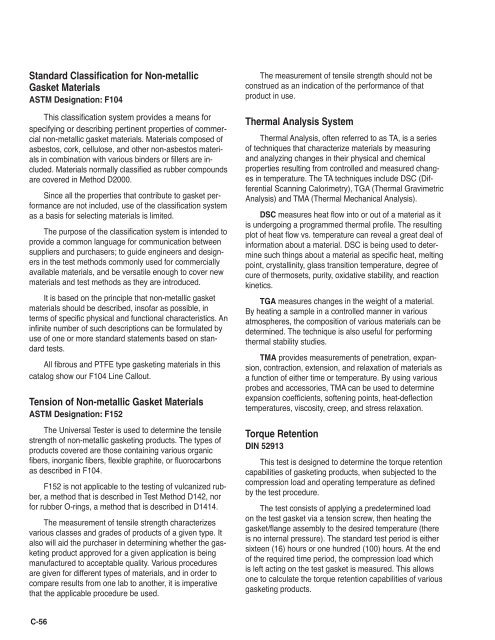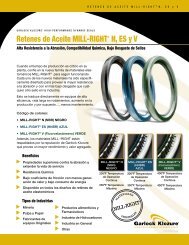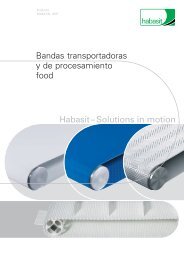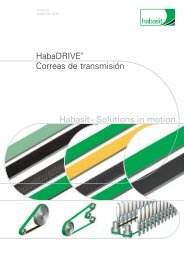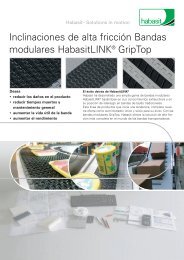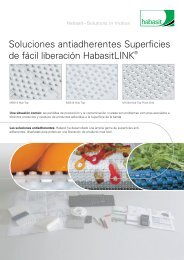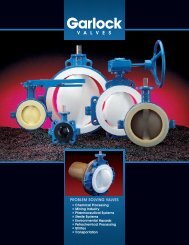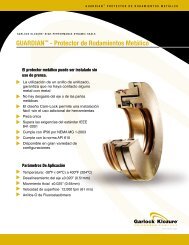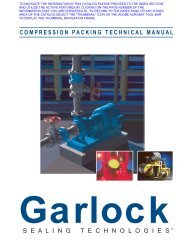Engineered Gasketing Products
Engineered Gasketing Products
Engineered Gasketing Products
- No tags were found...
Create successful ePaper yourself
Turn your PDF publications into a flip-book with our unique Google optimized e-Paper software.
Standard Classification for Non-metallicGasket MaterialsASTM Designation: F104This classification system provides a means forspecifying or describing pertinent properties of commercialnon-metallic gasket materials. Materials composed ofasbestos, cork, cellulose, and other non-asbestos materialsin combination with various binders or fillers are included.Materials normally classified as rubber compoundsare covered in Method D2000.Since all the properties that contribute to gasket performanceare not included, use of the classification systemas a basis for selecting materials is limited.The purpose of the classification system is intended toprovide a common language for communication betweensuppliers and purchasers; to guide engineers and designersin the test methods commonly used for commerciallyavailable materials, and be versatile enough to cover newmaterials and test methods as they are introduced.It is based on the principle that non-metallic gasketmaterials should be described, insofar as possible, interms of specific physical and functional characteristics. Aninfinite number of such descriptions can be formulated byuse of one or more standard statements based on standardtests.All fibrous and PTFE type gasketing materials in thiscatalog show our F104 Line Callout.Tension of Non-metallic Gasket MaterialsASTM Designation: F152The Universal Tester is used to determine the tensilestrength of non-metallic gasketing products. The types ofproducts covered are those containing various organicfibers, inorganic fibers, flexible graphite, or fluorocarbonsas described in F104.F152 is not applicable to the testing of vulcanized rubber,a method that is described in Test Method D142, norfor rubber O-rings, a method that is described in D1414.The measurement of tensile strength characterizesvarious classes and grades of products of a given type. Italso will aid the purchaser in determining whether the gasketingproduct approved for a given application is beingmanufactured to acceptable quality. Various proceduresare given for different types of materials, and in order tocompare results from one lab to another, it is imperativethat the applicable procedure be used.The measurement of tensile strength should not beconstrued as an indication of the performance of thatproduct in use.Thermal Analysis SystemThermal Analysis, often referred to as TA, is a seriesof techniques that characterize materials by measuringand analyzing changes in their physical and chemicalproperties resulting from controlled and measured changesin temperature. The TA techniques include DSC (DifferentialScanning Calorimetry), TGA (Thermal GravimetricAnalysis) and TMA (Thermal Mechanical Analysis).DSC measures heat flow into or out of a material as itis undergoing a programmed thermal profile. The resultingplot of heat flow vs. temperature can reveal a great deal ofinformation about a material. DSC is being used to determinesuch things about a material as specific heat, meltingpoint, crystallinity, glass transition temperature, degree ofcure of thermosets, purity, oxidative stability, and reactionkinetics.TGA measures changes in the weight of a material.By heating a sample in a controlled manner in variousatmospheres, the composition of various materials can bedetermined. The technique is also useful for performingthermal stability studies.TMA provides measurements of penetration, expansion,contraction, extension, and relaxation of materials asa function of either time or temperature. By using variousprobes and accessories, TMA can be used to determineexpansion coefficients, softening points, heat-deflectiontemperatures, viscosity, creep, and stress relaxation.Torque RetentionDIN 52913This test is designed to determine the torque retentioncapabilities of gasketing products, when subjected to thecompression load and operating temperature as definedby the test procedure.The test consists of applying a predetermined loadon the test gasket via a tension screw, then heating thegasket/flange assembly to the desired temperature (thereis no internal pressure). The standard test period is eithersixteen (16) hours or one hundred (100) hours. At the endof the required time period, the compression load whichis left acting on the test gasket is measured. This allowsone to calculate the torque retention capabilities of variousgasketing products.C-56


